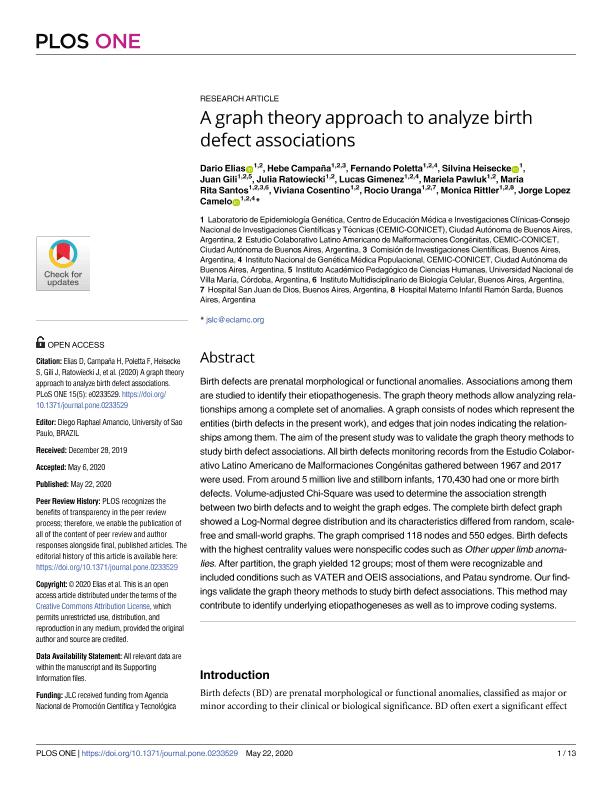Artículo
A graph theory approach to analyze birth defect associations
Elias, Dario Ezequiel; Campaña, Hebe; Poletta, Fernando Adrián ; Heisecke Peralta, Silvina Lidia
; Heisecke Peralta, Silvina Lidia ; Gili, Juan Antonio
; Gili, Juan Antonio ; Ratowiecki, Julia
; Ratowiecki, Julia ; Gimenez, Lucas Gabriel
; Gimenez, Lucas Gabriel ; Pawluk, Mariela Soledad
; Pawluk, Mariela Soledad ; Santos, María Rita
; Santos, María Rita ; Cosentino, Viviana Raquel; Uranga, Rocio; Rittler, Monica; López Camelo, Jorge Santiago
; Cosentino, Viviana Raquel; Uranga, Rocio; Rittler, Monica; López Camelo, Jorge Santiago
 ; Heisecke Peralta, Silvina Lidia
; Heisecke Peralta, Silvina Lidia ; Gili, Juan Antonio
; Gili, Juan Antonio ; Ratowiecki, Julia
; Ratowiecki, Julia ; Gimenez, Lucas Gabriel
; Gimenez, Lucas Gabriel ; Pawluk, Mariela Soledad
; Pawluk, Mariela Soledad ; Santos, María Rita
; Santos, María Rita ; Cosentino, Viviana Raquel; Uranga, Rocio; Rittler, Monica; López Camelo, Jorge Santiago
; Cosentino, Viviana Raquel; Uranga, Rocio; Rittler, Monica; López Camelo, Jorge Santiago
Fecha de publicación:
05/2020
Editorial:
Public Library of Science
Revista:
Plos One
ISSN:
1932-6203
Idioma:
Inglés
Tipo de recurso:
Artículo publicado
Clasificación temática:
Resumen
Birth defects are prenatal morphological or functional anomalies. Associations among them are studied to identify their etiopathogenesis. The graph theory methods allow analyzing relationships among a complete set of anomalies. A graph consists of nodes which represent the entities (birth defects in the present work), and edges that join nodes indicating the relationships among them. The aim of the present study was to validate the graph theory methods to study birth defect associations. All birth defects monitoring records from the Estudio Colaborativo Latino Americano de Malformaciones Congénitas gathered between 1967 and 2017 were used. From around 5 million live and stillborn infants, 170,430 had one or more birth defects. Volume-adjusted Chi-Square was used to determine the association strength between two birth defects and to weight the graph edges. The complete birth defect graph showed a Log-Normal degree distribution and its characteristics differed from random, scale-free and small-world graphs. The graph comprised 118 nodes and 550 edges. Birth defects with the highest centrality values were nonspecific codes such as Other upper limb anomalies. After partition, the graph yielded 12 groups; most of them were recognizable and included conditions such as VATER and OEIS associations, and Patau syndrome. Our findings validate the graph theory methods to study birth defect associations. This method may contribute to identify underlying etiopathogeneses as well as to improve coding systems.
Palabras clave:
BIRTH DEFECTS ASSOCIATIONS
,
GRAPH THEORY
,
ECLAMC
Archivos asociados
Licencia
Identificadores
Colecciones
Articulos(CEMIC-CONICET)
Articulos de CENTRO DE EDUCACION MEDICA E INVESTIGACIONES CLINICAS "NORBERTO QUIRNO"
Articulos de CENTRO DE EDUCACION MEDICA E INVESTIGACIONES CLINICAS "NORBERTO QUIRNO"
Articulos(IMBICE)
Articulos de INST.MULTIDISCIPL.DE BIOLOGIA CELULAR (I)
Articulos de INST.MULTIDISCIPL.DE BIOLOGIA CELULAR (I)
Citación
Elias, Dario Ezequiel; Campaña, Hebe; Poletta, Fernando Adrián; Heisecke Peralta, Silvina Lidia; Gili, Juan Antonio; et al.; A graph theory approach to analyze birth defect associations; Public Library of Science; Plos One; 15; 5; 5-2020; 1-13
Compartir
Altmétricas



